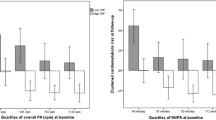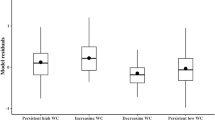Abstract
The aim of this study was to examine the associations of objectively measured physical activity (PA) and cardiorespiratory fitness (CRF) with different continuous metabolic syndrome (MetS) scores in adolescents. A cross-sectional sub-sample of 202 adolescents (99 girls), aged 13–17 years, were selected from the AFINOS Study. Body mass index, sum of 6 skindfold, waist circumference, systolic and diastolic blood pressure, insulin, glucose, triacylglycerol, and HDL-cholesterol levels were determined. Moderate PA (MPA), vigorous PA (VPA) and moderate to vigorous PA (MVPA) were assessed by the ActiGraph accelerometer for 7 consecutive days and CRF was estimated by the 20-m shuttle run test. Three continuous MetS scores were calculated according to the methodology of the Corpus Christi Child Heart Study (CCCHS), the Aerobic Center Longitudinal Study (ACLS), and the European Youth Heart Study (EYHS). VPA and MVPA were significantly related with CRF. Only CRF, and not patterns of PA, was inversely and independently associated with the three MetS scores although with different magnitudes (ranged: β = 0.22 to 0.36, p < 0.05). A significant VPA x CRF interaction (p = 0.011) was found using the ACLS MetS score. Trends across VPA-CRF groups were significantly different with ACLS and EYHS (p = 0.002 and p = 0.006, respectively), but not with CCCHS (p = 0.313) continuous MetS scores. These findings support the key role of CRF on the MetS and the relevance of PA, especially VPA, to provide CRF in adolescents. A unified pediatric definition of MetS might minimize the discrepancies among studies.
Similar content being viewed by others
References
Andersen, L.B., Harro, M., Sardinha, L.B., Froberg, K., Ekelund, U., Brage, S. and Anderssen, S.A. (2006): Physical activity and clustered cardiovascular risk in children: a cross-sectional study (The European Youth Heart Study).Lancet,368, 299–304.
Batey, L.S., Goff, D.C. Jr., Tortolero, S.R., Nichaman, M.Z., Chan, W., Chan, F.A., Grunbaum, J., Hanis, C.L. and Labarthe, D.R. (1997): Summary measures of the insulin resistance syndrome are adverse among Mexican-American versus non-Hispanic white children: the Corpus Christi Child Heart Study.Circulation,96, 4319–4325.
Blair, S.N., Kampert, J.B., Kohl, H.W. 3rd., Barlow, C.E., Macera, C.A., Paffenbarger, R.S. Jr. and Gibbons, L.W. (1996): Influences of cardiorespiratory fitness and other precursors on cardiovascular disease and all-cause mortality in men and women.JAMA,276, 205–210.
Bokor, S., Frelut, M.L., Vania, A., Hadjiathanasiou, C.G., Anastasakou, M., Malecka-Tendera, E., Matusik, P. and Molnár, D. (2008): Prevalence of metabolic syndrome in European obese children.Int J Pediatr Obes,3 (Suppl. 2), 3–8.
Boreham, C., Twisk, J., Neville, C., Savage, M., Murray, L. and Gallagher, A. (2002): Associations between physical fitness and activity patterns during adolescence and cardiovascular risk factors in young adulthood: the Northern Ireland Young Hearts Project.Int J Sports Med,23 (Suppl. 1), 22–26.
Boreham, C.A., Paliczka, V.J. and Nichols, A.K. (1990): A comparison of the PWC170 and 20-MST tests of aerobic fitness in adolescent schoolchildren.J Sports Med Phys Fitness,30, 19–23.
Brage, S., Wedderkopp, N., Ekelund, U., Franks, P.W., Wareham, N.J., Andersen, L.B. and Froberg, K.; European Youth Heart Study (EYHS). (2004): Features of the metabolic syndrome are associated with objectively measured physical activity and fitness in Danish children: the European Youth Heart Study (EYHS).Diabetes Care,27, 2141–2148.
Bueno, G., Bueno, O., Moreno, L.A., García, R., Tresaco, B., Garagorri, J.M. and Bueno M. (2006): Diversity of metabolic syndrome risk factors in obese children and adolescents.J Physiol Biochem,62, 125–133.
Cali, A.M. and Caprio, S. (2008): Obesity in children and adolescents.J Clin Endocrinol Metab,11 (Suppl. 1), 31–36.
Cole, T.J., Bellizzi, M.C., Flegal, K.M. and Dietz, W.H. (2000): Establishing a standard definition for child overweight and obesity worldwide: international survey.BMJ,320, 1240–1243.
Cook, S., Weitzman, M., Auinger, P., Nguyen, M. and Dietz, W.H. (2003): Prevalence of a metabolic syndrome phenotype in adolescents: findings from the third National Health and Nutrition Examination Survey, 1988–1994.Arch Pediatr Adolesc Med,157, 821–827.
De-Ferranti, S.D., Gauvreau, K., Ludwig, D.S., Neufeld, E.J., Newburger, J.W. and Rifai, N. (2004): Prevalence of the metabolic syndrome in American adolescents: findings from the Third National Health and Nutrition Examination Survey.Circulation,110, 2494–2497.
DeFronzo, R.A. and Ferrannini, E. (1991): Insulin resistance. A multifaceted syndrome responsible for NIDDM, obesity, hypertension, dyslipidemia, and atherosclerotic cardiovascular disease.Diabetes Care,14, 173–194.
Eckel, R.H., Grundy, S.M. and Zimmet, P.Z. (2005): The metabolic syndrome.Lancet,365, 1415–1428.
Eisenmann, J.C. (2007): Aerobic fitness, fatness and the metabolic syndrome in children and adolescents.Acta Paediatr,96, 1723–1729.
Eisenmann, J.C. (2008): On the use of a continuous metabolic syndrome score in pediatric research.Cardiovasc Diabetol,7, 17.
Eisenmann, J.C., Wickel, E.E., Welk, G.J. and Blair, S.N. (2005): Relationship between adolescent fitness and fatness and cardiovascular disease risk factors in adulthood: the Aerobics Center Longitudinal Study (ACLS).Am Heart J,149, 46–53.
Ekelund, U., Anderssen, S.A., Froberg, K., Sardinha, L.B., Andersen, L.B. and Brage, S.; European Youth Heart Study Group. (2007): Independent associations of physical activity and cardiorespiratory fitness with metabolic risk factors in children: the European youth heart study.Diabetología,50, 1832–1840.
Farrell, S.W., Braun, L., Barlow, C.E., Cheng, Y.J. and Blair, S.N. (2002): The relation of body mass index, cardiorespiratory fitness, and all-cause mortality in women.Obes Res,10, 417–423.
Fedorov, V., Mannino, F. and Zhang, R. (2009): Consequences of dichotomization.Pharm Stat,8, 50–61.
Ferreira, I., Twisk, J.W., van-Mechelen, W., Kemper, H.C. and Stehouwer, C.D. (2005): Development of fatness, fitness, and lifestyle from adolescence to the age of 36 years: determinants of the metabolic syndrome in young adults: the amsterdam growth and health longitudinal study.Arch Intern Med,165, 42–48.
Freedson, P., Pober, D. and Janz, K.F. (2005): Calibration of accelerometer output for children.Med Sci Sports Exerc,37 (Suppl. 11), 523–530.
Gutin, B., Yin, Z., Humphries, M.C. and Barbeau, P. (2005): Relations of moderate and vigorous physical activity to fitness and fatness in adolescents.Am J Clin Nutr,81, 746–750.
Hallal, P.C., Victora, C.G., Azevedo, M.R. and Wells, J.C. (2006): Adolescent physical activity and health: a systematic review.Sports Med,36, 1019–1030.
Janz, K.F., Dawson, J.D. and Mahoney, L.T. (2002): Increases in physical fitness during childhood improve cardiovascular health during adolescence: the Muscatine Study.Int J Sports Med,23 (Suppl. 1), 15–21.
Jurca, R., Lamonte, M.J., Church, T.S., Earnest, C.P., Fitzgerald, S.J., Barlow, C.E., Jordan, A.N., Kampert, J.B. and Blair, S.N. (2004): Associations of muscle strength and fitness with metabolic syndrome in men.Med Sci Sports Exerc,36, 1301–1307.
Kaplan, N.M. (1989): The deadly quartet. Upper-body obesity, glucose intolerance, hypertriglyceridemia, and hypertension.Arch Intern Med,149, 1514–1520.
Katzmarzyk, P.T., Church, T.S. and Blair, S.N. (2004): Cardiorespiratory fitness attenuates the effects of the metabolic syndrome on all-cause and cardiovascular disease mortality in men.Arch Intern Med,164, 1092–1097.
Léger, L.A., Mercier, D., Gadoury, C. and Lambert, J. (1988): The multistage 20 metre shuttle run test for aerobic fitness.J Sports Sci,6, 93–101.
Lobelo, F. and Ruiz, J.R. (2007): Cardiorespiratory fitness as criterion validity for health-based metabolic syndrome definition in adolescents.J Am Coll Cardiol,50, 471.
Malina, R.M. (2001): Physical activity and fitness: pathways from childhood to adulthood.Am J Hum Biol,13, 162–172.
Martínez-Gómez, D., Welk, G.J., Calle, M.E., Marcos, A. and Veiga, O.; and the AFINOS Study Group. (2009): Preliminary evidence of physical activity levels measured by accelerometer in Spanish adolescents. The AFINOS Study.Nutr Hosp,24, 212–218.
Moreno, L.A., Joyanes, M., Mesana, M.I., González-Gross, M., Gil, C.M., Sarría, A., Gutierrez, A., Garaulet, M., Perez-Prieto, R., Bueno, M. and Marcos, A.; AVENA Study Group. (2003): Harmonization of anthropometric measurements for a multicenter nutrition survey in Spanish adolescents.Nutrition,19, 481–486.
Moreno, L.A., Mesana, M.I., González-Gross, M., Gil, C.M., Fleta, J., Wärnberg, J., Ruiz, J.R., Sarría, A., Marcos, A. and Bueno, M; The AVENA Study Group. (2006): Anthropometric body fat composition reference values in Spanish adolescents. The AVENA Study.Eur J Clin Nutr,60, 191–196.
Nader, P.R., Bradley, R.H., Houts, R.M., McRitchie, S.L. and O’Brien, M. (2008): Moderate-to-vigorous physical activity from ages 9 to 15 years.JAMA, 300, 295–305.
Ortega, F.B., Ruiz, J.R., Hurtig-Wennlöf, A., Vicente-Rodriguez, G., Rizzo, N.S., Castillo, M.J. and Sjöström, M.: Cardiovascular fitness modifies the associations between physical activity and abdominal adiposity in children and adolescents. The European Youth Heart Study.Br J Sports Med (in press).
Ortega, F.B., Ruiz, J.R. and Sjöström, M. (2007): Physical activity, overweight and central adiposity in Swedish children and adolescents: the European Youth Heart Study.Int J Behav Nutr Phys Act,4, 61.
Pietrobelli, A., Malavolti, M., Battistini, N.C. and Fuiano, N. (2008): Metabolic syndrome: a child is not a small adult.Int J Pediatr Obes,3 (Suppl. 1), 67–71.
Public Health Canada. (2002): “Family guide to physical activity for youth 10–14 years of age”. Government of Canada, Otawa.
Reaven, G.M. (1993): Role of insulin resistance in human disease (syndrome X): an expanded definition.Annu Rev Med,44, 121–131.
Reinehr, T., de-Sousa, G., Toschke, A.M. and Andler, W. (2007): Comparison of metabolic syndrome prevalence using eight different definitions: a critical approach.Arch Dis Child,92, 1067–1072.
Rizzo, N.S., Ruiz, J.R., Oja, L., Veidebaum, T. and Sjöström, M. (2008): Associations between physical activity, body fat, and insulin resistance (homeostasis model assessment) in adolescents: the European Youth Heart Study.Am J Clin Nutr,87, 586–592.
Sirard, J.R. and Pate, R.R. (2001): Physical activity assessment in children and adolescents.Sports Med,31, 439–454.
Steinberger, J. and Daniela, S.R.; American Heart Association Atherosclerosis, Hypertension, and Obesity in the Young Committee (Council on Cardiovascular Disease in the Young); American Heart Association Diabetes Committee (Council on Nutrition, Physical Activity, and Metabolism). (2003): Obesity, insulin resistance, diabetes, and cardiovascular risk in children: an American Heart Association scientific statement from the Atherosclerosis, Hypertension, and Obesity in the Young Committee (Council on Cardiovascular Disease in the Young) and the Diabetes Committee (Council on Nutrition, Physical Activity, and Metabolism).Circulation,107, 1448–1453.
Strong, W.B., Malina, R.M., Blimkie, C.J., Daniels, S.R., Dishman, R.K., Gutin, B., Hergenroeder, A.C., Must, A., Nixon, P.A., Pivarnik, J.M., Rowland, T., Trost, S. and Trudeau, F. (2005): Evidence based physical activity for school-age youth.J Pediatr,146, 732–737.
Tanner, J.M. and Whitehouse, R.H. (1976): Clinical longitudinal standards for height, weight, height velocity, weight velocity, and stages of puberty.Arch Dis Child,51, 170–179.
Teran-Garcia, M., Rankinen, T. and Bouchard, C. (2008): Genes, exercise, growth, and the sedentary, obese child.J Appl Physiol,105, 988–1001.
Tomkinson, G.R., Léger, L.A., Olds, T.S. and Cazorla G. (2003): Secular trends in the performance of children and adolescents (1980–2000): an analysis of 55 studies of the 20m shuttle run test in 11 countries.Sports Med,33, 285–300.
Topouchian, J.A., El Assaad M.A., Orobinskaia, L.V., El Feghali R.N., and Asmar R.G. (2006): Validation of two automatic devices for self-measurement of blood pressure according to the International Protocol of the European Society of Hypertension: the Omron M6 (HEM-7001-E) and the Omron R7 (HEM 637-IT).Blood Press Monit,11, 165–71.
Troiano, R.P., Berrigan, D., Dodd, K.W., Mâsse, L.C., Tilert, T. and McDowell, M. (2008): Physical activity in the United States measured by accelerometer.Med Sci Sports Exerc,40, 181–188.
Trost, S.G., Way, R. and Okely, A.D. (2006): Predictive validity of three ActiGraph energy expenditure equations for children.Med Sci Sports Exerc,38, 380–387.
Twisk, J.W., Kemper, H.C. and van-Mechelen, W. (2002): The relationship between physical fitness and physical activity during adolescence and cardiovascular disease risk factors at adult age. The Amsterdam Growth and Health Longitudinal Study.Int J Sports Med,23 (Suppl. 1), 8–14
Weiss, R., Dziura, J., Burgert, T.S., Tamborlane, W.V., Taksali, S.E., Yeckel, C.W., Allen, K., Lopes, M., Savoye, M., Morrison, J., Sherwin, R.S. and Caprio, S. (2004): Obesity and the metabolic syndrome in children and adolescents.N Engl J Med,350, 2362–2374.
Wijndaele, K., Beunen, G., Duvigneaud, N., Matton, L., Duquet, W., Thomis, M., Lefevre, J. and Philippaerts, R.M. (2006): A continuous metabolic syndrome risk score: utility for epidemiological analyses.Diabetes Care,29, 2329.
World Health Organization. (2003): “Diet, nutrition and the prevention of chronic diseases. Report of a Joint WHO/FAO Expert Consultation”. World Health Organization, Geneva.
World Health Organization. (2004): “Global Strategy on Diet, Physical Activity and Health”. World Health Organization, Geneva.
Author information
Authors and Affiliations
Corresponding author
Additional information
With the AFINOS Study Group.
Rights and permissions
About this article
Cite this article
Martínez-Gómez, D., Eisenmann, J.C., Moya, J.M. et al. The role of physical activity and fitness on the metabolic syndrome in adolescents: effect of different scores. The AFINOS Study. J Physiol Biochem 65, 277–289 (2009). https://doi.org/10.1007/BF03180580
Received:
Issue Date:
DOI: https://doi.org/10.1007/BF03180580




